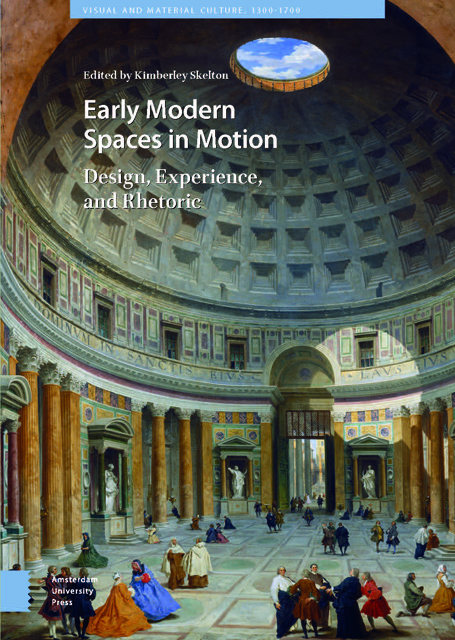Book contents
- Frontmatter
- Table of Contents
- List of Illustrations
- Acknowledgements
- Introduction: Bodies and Buildings in Motion
- 1 Navigating the Palace Underworld : Recreational Space, Pleasure, and Release at the Castello del Buonconsiglio, Trent
- 2 Passages to Fantasy : The Performance of Motion in Celliniâs Fontainebleau Portal and the Galerie François I
- 3 The Catholic Country House in Early Modern England : Motion, Pietyand Hospitality, c. 1580â1640
- 4 Sensory Vibrations and Social Reform at San Michele a Ripa in Rome
- 5 The Rise of the Staircase: Motion in Eighteenth-Century Dutch Domestic Architecture
- 6 Movement through Ruins: Re-experiencing Ancient Baalbek with Jean de la Roque
- 7 A Paper Tour of the Metropolis : The Architecture of Early Modern London in the Royal Magazine
- 8 Libraries in Motion: Forms of Movement in the Early Modern Library (1450-1770)
- Works Cited
- Index
5 - The Rise of the Staircase: Motion in Eighteenth-Century Dutch Domestic Architecture
Published online by Cambridge University Press: 11 January 2023
- Frontmatter
- Table of Contents
- List of Illustrations
- Acknowledgements
- Introduction: Bodies and Buildings in Motion
- 1 Navigating the Palace Underworld : Recreational Space, Pleasure, and Release at the Castello del Buonconsiglio, Trent
- 2 Passages to Fantasy : The Performance of Motion in Celliniâs Fontainebleau Portal and the Galerie François I
- 3 The Catholic Country House in Early Modern England : Motion, Pietyand Hospitality, c. 1580â1640
- 4 Sensory Vibrations and Social Reform at San Michele a Ripa in Rome
- 5 The Rise of the Staircase: Motion in Eighteenth-Century Dutch Domestic Architecture
- 6 Movement through Ruins: Re-experiencing Ancient Baalbek with Jean de la Roque
- 7 A Paper Tour of the Metropolis : The Architecture of Early Modern London in the Royal Magazine
- 8 Libraries in Motion: Forms of Movement in the Early Modern Library (1450-1770)
- Works Cited
- Index
Summary
Abstract
In the eighteenth-century homes of the Dutch elite, the indispensable but inconspicuous device of the stairs developed into a monumental, designed centrepiece of the house. This contribution considers the new open-well staircase in the broader context of the growing demand for social space, a recurring interest in French (court) culture and fashion, and a specific interest among the Dutch elite in graceful movement of the civilized human body. A closer study of architectural model books, etiquette manuals, and reflections on cultured behavior, style, elegance, and physical movement helps to explain the rise of this space-consuming element in eighteenth-century houses in the Netherlands and Amsterdam in particular.
Keywords: staircase, domestic architecture, print culture, Netherlands, Amsterdam
Today, people build entirely in the French style: they do not mind the facade, they prefer big windows to be able to place expensive curtains and blinds, and where in the previous century a small staircase was made, when they had big rooms, they now spoil the small rooms and the whole house to have a beautiful staircase.
This appreciation of Amsterdam houses appeared in 1767 in the journal De Philosooph (The Philosopher) in an anonymous, polemic article that describes the general docility in matters of style and the lack of taste in the Netherlands, demonstrated in a critical evaluation of Amsterdam architecture. The author was not much later identified as the internationally renowned doctor Petrus Camper, professor in medicine, anatomist, natural scientist, amateur draughtsman, prolific publicist, and probably the first Dutch architecture critic. Camper, who was more of a virtuoso than an amateur, sketches a development in Amsterdam domestic architecture that is surprisingly accurate in his observation, not only of a strong preference for a French manner in domestic architecture, but especially of the rise of the monumental staircase, or stair hall with open-well stairs that replaced the small wooden newel(-post), or spiral, stair residing in the corner of the front room of the typical seventeenth-century Dutch house. From an indispensable but inconspicuous device, stairs were transformed into a monumental, designed centrepiece of the eighteenth-century house. The increasing presence of the staircase in the homes of the Dutch elite has been noted in scholarship, without however connecting it to the dynamics of fashionable culture of the time that demonstrates a special interest in motion.
- Type
- Chapter
- Information
- Early Modern Spaces in MotionDesign, Experience and Rhetoric, pp. 139 - 162Publisher: Amsterdam University PressPrint publication year: 2020



